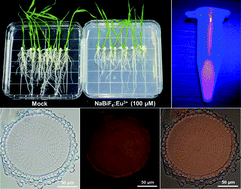当前位置:
X-MOL 学术
›
Photochem. Photobiol. Sci.
›
论文详情
Our official English website, www.x-mol.net, welcomes your
feedback! (Note: you will need to create a separate account there.)
Real-time detection of the nanoparticle induced phytotoxicity in rice root tip through the visible red emissions of Eu3+ ions†
Photochemical & Photobiological Sciences ( IF 2.7 ) Pub Date : 2018-03-08 00:00:00 , DOI: 10.1039/c8pp00003d Peng Du 1, 2, 3, 4 , Yunfei Wu 2, 4, 5, 6 , Jae Su Yu 1, 2, 3, 4
Photochemical & Photobiological Sciences ( IF 2.7 ) Pub Date : 2018-03-08 00:00:00 , DOI: 10.1039/c8pp00003d Peng Du 1, 2, 3, 4 , Yunfei Wu 2, 4, 5, 6 , Jae Su Yu 1, 2, 3, 4
Affiliation

|
Phytotoxicity is one of the most important factors involved in the reduction of crop production. With the introduction of NaBiF4 nanoparticles, the effect of the particle size (>50 nm) on rice development was systematically studied. Through the exogenous treatment of multiple concentrations of nanoparticles, the primary root length, lateral root number, and lateral root length were significantly inhibited under higher content of nanoparticles, but more crown root formation was induced, which might be due to phytotoxicity. With the help of the red emission of the Eu3+-activated NaBiF4 nanoparticles, we could infer that the nanoparticles were accumulated in the root tip cells in the division and elongation zone but not in the mature region. Additionally, the investigation on the influence of the studied nanoparticles on the gene level and the expression of phytotoxicity related genes was performed to further identify the effect of the nanoparticles on the rice root development. These results potentially explain the effect of larger nanoparticles on phytotoxicity in the plant roots.
中文翻译:

通过可见的Eu 3+离子红色发射,实时检测纳米颗粒在水稻根尖中引起的植物毒性†
植物毒性是减少作物产量的最重要因素之一。随着NaBiF 4纳米颗粒的引入,系统地研究了粒径(> 50 nm)对水稻发育的影响。通过外源处理多种浓度的纳米颗粒,在较高含量的纳米颗粒下显着抑制了初生根长,侧根数和侧根长,但诱导了更多的冠根形成,这可能是由于植物毒性所致。借助Eu 3+活化的NaBiF 4的红色发射我们可以推断出纳米粒子聚集在分裂和延伸区的根尖细胞中,而不是成熟区域中。此外,对所研究的纳米颗粒对基因水平的影响以及与植物毒性相关基因的表达进行了研究,以进一步确定纳米颗粒对水稻根系发育的影响。这些结果可能解释了较大的纳米颗粒对植物根部植物毒性的影响。
更新日期:2018-03-08
中文翻译:

通过可见的Eu 3+离子红色发射,实时检测纳米颗粒在水稻根尖中引起的植物毒性†
植物毒性是减少作物产量的最重要因素之一。随着NaBiF 4纳米颗粒的引入,系统地研究了粒径(> 50 nm)对水稻发育的影响。通过外源处理多种浓度的纳米颗粒,在较高含量的纳米颗粒下显着抑制了初生根长,侧根数和侧根长,但诱导了更多的冠根形成,这可能是由于植物毒性所致。借助Eu 3+活化的NaBiF 4的红色发射我们可以推断出纳米粒子聚集在分裂和延伸区的根尖细胞中,而不是成熟区域中。此外,对所研究的纳米颗粒对基因水平的影响以及与植物毒性相关基因的表达进行了研究,以进一步确定纳米颗粒对水稻根系发育的影响。这些结果可能解释了较大的纳米颗粒对植物根部植物毒性的影响。









































 京公网安备 11010802027423号
京公网安备 11010802027423号